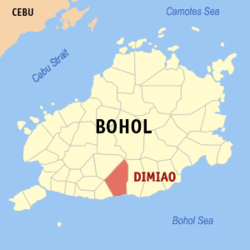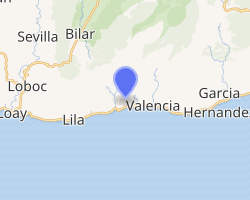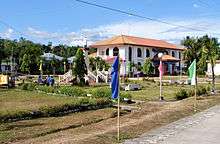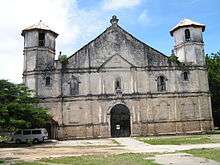Dimiao, Bohol
Dimiao, officially the Municipality of Dimiao (Cebuano: Lungsod sa Dimiao; Tagalog: Bayan ng Dimiao), is a 4th class municipality in the province of Bohol, Philippines. According to the 2015 census, it has a population of 14,364 people.[3]
Dimiao | |
|---|---|
| Municipality of Dimiao | |
 National Road in Dimiao | |
 Map of Bohol with Dimiao highlighted | |
OpenStreetMap 
| |
.svg.png) Dimiao Location within the Philippines | |
| Coordinates: 9°37′N 124°10′E | |
| Country | |
| Region | Central Visayas (Region VII) |
| Province | Bohol |
| District | 3rd District |
| Founded | 22 January 1769 |
| Barangays | 35 (see Barangays) |
| Government | |
| • Type | Sangguniang Bayan |
| • Mayor | Randolph L. Ang |
| • Vice Mayor | Gilberto C. Lagua |
| • Congressman | Kristine Alexie B. Tutor |
| • Electorate | 11,106 voters (2019) |
| Area | |
| • Total | 135.75 km2 (52.41 sq mi) |
| Population (2015 census)[3] | |
| • Total | 14,364 |
| • Density | 110/km2 (270/sq mi) |
| • Households | 3,219 |
| Economy | |
| • Income class | 4th municipal income class |
| • Poverty incidence | 27.13% (2015)[4] |
| • Revenue (₱) | 66,145,120.93 (2016) |
| Time zone | UTC+8 (PST) |
| ZIP code | 6305 |
| PSGC | |
| IDD : area code | +63 (0)38 |
| Climate type | tropical monsoon climate |
| Native languages | Boholano dialect Cebuano Tagalog |
The municipality of Dimiao, including its church and municipal hall, lies alongside the C.P.G. circumferential road on the southern coast of the island, about 36 kilometres (22 mi) east of Tagbilaran.[5]
History
When the parish was founded is uncertain, although baptism records dates back to the year 1750. It is one of the older municipalities of Bohol, with a population of 8,820 in 1897. This town used to cover a large area that included the municipalities of Valencia and Lila. In 1867, Valencia was separated from Dimiao because of increased population, and Lila was made an independent municipality on 1 January 1915.[6]
Barangays
Dimiao comprises 35 barangays:
| PSGC | Barangay | Population | ±% p.a. | |||
|---|---|---|---|---|---|---|
| 2015[3] | 2010[7] | |||||
| 071220001 | Abihid | 2.4% | 343 | 333 | 0.56% | |
| 071220002 | Alemania | 1.2% | 167 | 208 | −4.09% | |
| 071220003 | Baguhan | 2.3% | 334 | 324 | 0.58% | |
| 071220004 | Bakilid | 1.1% | 164 | 165 | −0.12% | |
| 071220005 | Balbalan | 1.9% | 278 | 273 | 0.35% | |
| 071220006 | Banban | 3.6% | 520 | 521 | −0.04% | |
| 071220007 | Bauhugan | 2.2% | 316 | 308 | 0.49% | |
| 071220008 | Bilisan | 1.1% | 164 | 161 | 0.35% | |
| 071220009 | Cabagakian | 3.8% | 545 | 649 | −3.27% | |
| 071220010 | Cabanbanan | 2.5% | 352 | 416 | −3.13% | |
| 071220011 | Cadap‑agan | 3.3% | 469 | 445 | 1.01% | |
| 071220012 | Cambacol | 1.8% | 256 | 248 | 0.61% | |
| 071220013 | Cambayaon | 2.9% | 415 | 372 | 2.10% | |
| 071220014 | Canhayupon | 4.6% | 661 | 669 | −0.23% | |
| 071220015 | Canlambong | 3.3% | 477 | 526 | −1.84% | |
| 071220016 | Casingan | 1.4% | 199 | 207 | −0.75% | |
| 071220017 | Catugasan | 1.9% | 267 | 313 | −2.98% | |
| 071220018 | Datag | 1.7% | 241 | 221 | 1.66% | |
| 071220019 | Guindaguitan | 3.0% | 437 | 455 | −0.77% | |
| 071220020 | Guingoyuran | 3.6% | 514 | 538 | −0.87% | |
| 071220021 | Ile | 1.8% | 254 | 269 | −1.09% | |
| 071220022 | Lapsaon | 3.0% | 424 | 455 | −1.33% | |
| 071220023 | Limokon Ilaod | 3.7% | 526 | 641 | −3.69% | |
| 071220024 | Limokon Ilaya | 4.6% | 654 | 724 | −1.92% | |
| 071220025 | Luyo | 5.8% | 836 | 960 | −2.60% | |
| 071220026 | Malijao | 2.1% | 295 | 319 | −1.48% | |
| 071220027 | Oac | 5.1% | 732 | 805 | −1.79% | |
| 071220028 | Pagsa | 2.3% | 332 | 309 | 1.38% | |
| 071220029 | Pangihawan | 1.3% | 187 | 242 | −4.79% | |
| 071220031 | Puangyuta | 2.2% | 312 | 297 | 0.94% | |
| 071220030 | Sawang | 3.6% | 514 | 491 | 0.88% | |
| 071220033 | Tangohay | 4.7% | 671 | 635 | 1.06% | |
| 071220036 | Taongon Cabatuan | 3.7% | 533 | 594 | −2.04% | |
| 071220038 | Taongon Can‑andam | 4.8% | 683 | 802 | −3.01% | |
| 071220037 | Tawid Bitaog | 2.0% | 292 | 271 | 1.43% | |
| Total | 14,364 | 15,166 | −1.03% | |||
|}
Climate
| Climate data for Dimiao, Bohol | |||||||||||||
|---|---|---|---|---|---|---|---|---|---|---|---|---|---|
| Month | Jan | Feb | Mar | Apr | May | Jun | Jul | Aug | Sep | Oct | Nov | Dec | Year |
| Average high °C (°F) | 28 (82) |
29 (84) |
30 (86) |
31 (88) |
31 (88) |
30 (86) |
30 (86) |
30 (86) |
30 (86) |
29 (84) |
29 (84) |
29 (84) |
30 (85) |
| Average low °C (°F) | 23 (73) |
22 (72) |
23 (73) |
23 (73) |
24 (75) |
25 (77) |
24 (75) |
24 (75) |
24 (75) |
24 (75) |
23 (73) |
23 (73) |
24 (74) |
| Average precipitation mm (inches) | 102 (4.0) |
85 (3.3) |
91 (3.6) |
75 (3.0) |
110 (4.3) |
141 (5.6) |
121 (4.8) |
107 (4.2) |
111 (4.4) |
144 (5.7) |
169 (6.7) |
139 (5.5) |
1,395 (55.1) |
| Average rainy days | 18.6 | 14.8 | 16.5 | 16.7 | 23.9 | 26.4 | 25.6 | 24.1 | 24.4 | 26.3 | 23.7 | 20.5 | 261.5 |
| Source: Meteoblue [8] | |||||||||||||
Demographics
|
| ||||||||||||||||||||||||||||||||||||||||||||||||
| Source: Philippine Statistics Authority[3][7][9][10] | |||||||||||||||||||||||||||||||||||||||||||||||||
Economy
The people of Dimiao lives on farming, tubâ-gathering, rope-making and fishing since it is located along the coast. Rice, corn, maguey, copra, rope, mango and tubâ are their most important products.
Attractions


The town of Dimiao has its share of Bohol's list of natural and man-made attractions.
- Dimiao Church
- The San Nicholas Church is one of the oldest stone churches of Bohol, built in the later half of the 19th century. It is identified by its twin bell towers either side of the church's front façade, and it is dedicated to San Nicolas Tolentino, who is also the town's patron saint and whose feast day is celebrated 10 September.[11] In front of the church building is a tower with the image of the Sacred Heart of Jesus where the "hugos" is done during dawn rites (salubong) of Easter Sunday. The church houses some relics from the Spanish Regime and is being preserved.
- The building behind the church served once as a convent but is now a school. Fronting the Sacred Heart tower is a monument dedicated to the Philippines' national hero, José Rizal. Across from the church, across the circumferential road lies the municipal hall, a typical Spanish-designed building with prominent arched windows, white painted walls and red roof.
- Ermita Ruins
- The Ermita Ruins are the ruins of a coralline limestone structure built during the Spanish Regime. It lies parallel to the nave of the St. Nicholas Tolentino Church. It was allegedly used as a military fortress, a chapel and a burial site of the members of the Spanish clergy. Archaeological excavations were undertaken in 1995 and 1998 in a quest to uncover its mysterious past.
- Balbalan Beach
- Balbalan Beach lies on a long stretch of white sandy beach facing the Mindanao Sea. It is only five minutes drive away from the town center in Balbalan. The waters are unpolluted and crystal clear, very ideal for swimming. Out in the deep are colorful coral reefs. Sailing is also a pastime in the area but make sure that you finished all of your activities before the sunsets or else, manananggals will feast on your poor body when you are out in the open at night. This is how the town got its name, balbal means to eat out the innards of humans like an animal, in reference to the manananggals in the area...or if you really want to stay here at night, better bring out some big guns with a dash of holy guidance after a priestly confession.
- Seaside Beach Resort
- Seaside Beach Resort once called Imelda Beach in Luyo boast a stretch of white sand fringed with tall coconut palm trees. The waters are clear and unpolluted. The beach is fairly accessible, lying along the National Highway. It was once the venue of an encampment of the Boys and Girls Scouts of Bohol. On clear sunny days, Camiguin Island with the silhouette of Mount Hibok-Hibok can be seen.
- Dimiao Twin Falls
- The Dimiao Twin Falls cascades over a cliff, 14 kilometres (8.7 mi) away from the highway. Its rugged pathway is a challenge to trekkers who are rewarded with a panoramic view of the falls upon arrival. Dry land near the foot of the falls is ideal for picnics.
- Pahangog Twin Falls and Caverns
- The Pahangog Twin Falls cascades over a 30-metre (98 ft) high cliff surrounded by a lush forest of tropical trees and flora. A natural basin carved out from underneath the falling waters serves as a natural swimming pool for bathers. Two caves lie near the falls with rock formations carved by centuries of gushing waters; one cavern has a naturally-contoured basin that fills up with water before flowing outwards from the cave.
- Ingkumhan Falls
- At Guingoyuran.
- Dam-agan Falls
- At Pagsa.
- Rice Terraces
- Although not as large nor prominent as the rice terraces of Banaue, the terraces look like a velvety green layered field, and during near-harvest season, the fields turn into gold.
- MacArthur's Cap
- The MacArthur’s Cap is a rock formation resembling an army officer's cap that one encounters when entering the town of Dimiao. The rock formation has become an emblem and called such at the successful return of General Douglas MacArthur, upon the defeat of the Japanese Army during World War II.
- Badiang Peak
- Badiang Peak is a rugged mountain of Dimiao which can be visited by trekkers and mountain climbers. Hours of trekking along pathways and climbing over boulders are rewarded with a panoramic view of Dimiao and its neighboring lowlands from the mountain peak.
- Fish Sanctuary
- At Taongon Can-andam
Education
The town has schools scattered throughout the barangays. Those located at the town proper are the Banban Elementary School, the Dimiao National High School and a private one, the St. Nicholas Academy. 90% of the inhabitants are literate and most speak some English and Filipino.
References
- "Municipality". Quezon City, Philippines: Department of the Interior and Local Government. Retrieved 31 May 2013.
- "Province: Bohol". PSGC Interactive. Quezon City, Philippines: Philippine Statistics Authority. Retrieved 12 November 2016.
- Census of Population (2015). "Region VII (Central Visayas)". Total Population by Province, City, Municipality and Barangay. PSA. Retrieved 20 June 2016.
- "PSA releases the 2015 Municipal and City Level Poverty Estimates". Quezon City, Philippines. Retrieved 12 October 2019.
- "Welcome to Dimiao Bohol". "www.bohol-philippines.com". Retrieved February 7, 2019.
- "Municipality of Dimiao". Province of Bohol. Retrieved 30 January 2015.
- Census of Population and Housing (2010). "Region VII (Central Visayas)". Total Population by Province, City, Municipality and Barangay. NSO. Retrieved 29 June 2016.
- "Dimiao: Average Temperatures and Rainfall". Meteoblue. Retrieved 9 May 2020.
- Censuses of Population (1903–2007). "Region VII (Central Visayas)". Table 1. Population Enumerated in Various Censuses by Province/Highly Urbanized City: 1903 to 2007. NSO.
- "Province of Bohol". Municipality Population Data. Local Water Utilities Administration Research Division. Retrieved 17 December 2016.
- "Bohol Festivals Timetable". "www.bohol-philippines.com". Retrieved 2019-03-18.
Sources
"Ermita Ruins". Municipality of Dimiao. 2010. Archived from the original on 28 October 2012.CS1 maint: ref=harv (link)
External links
| Wikimedia Commons has media related to Dimiao, Bohol. |